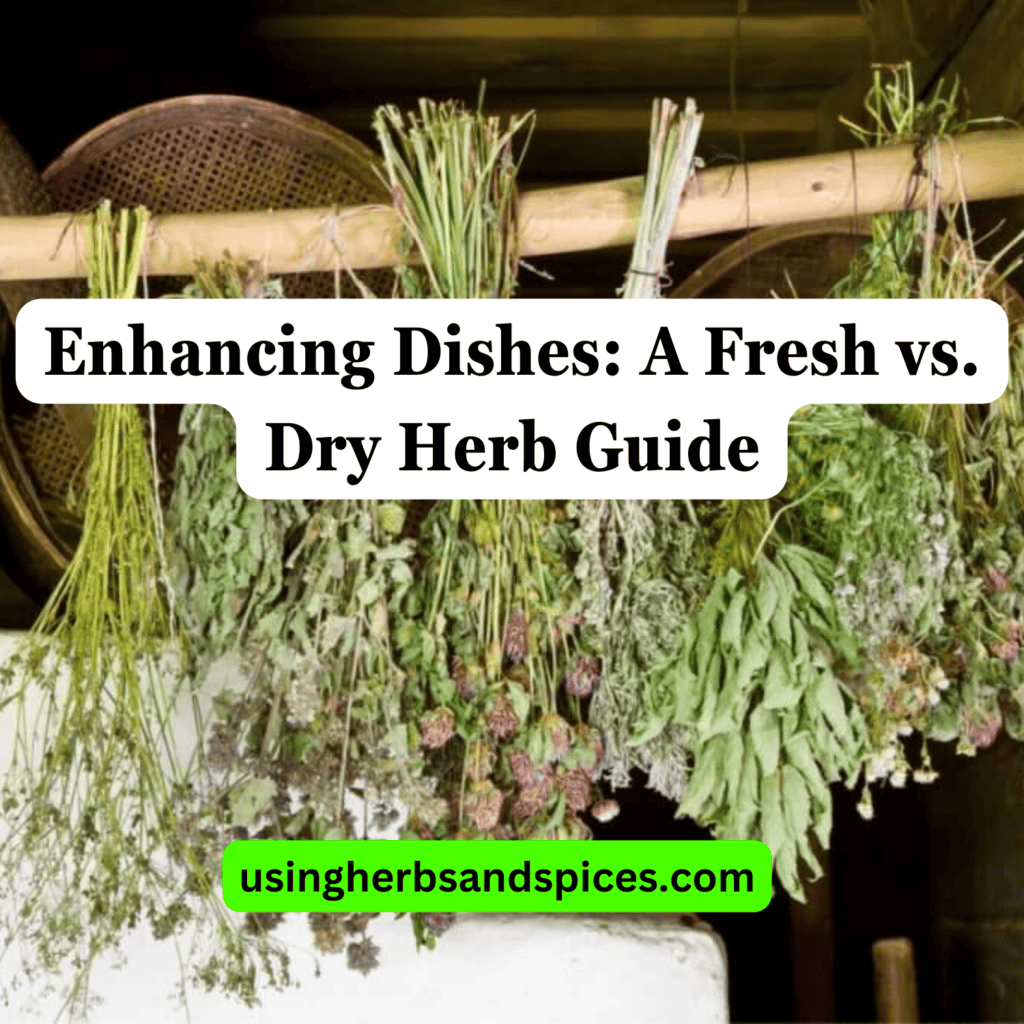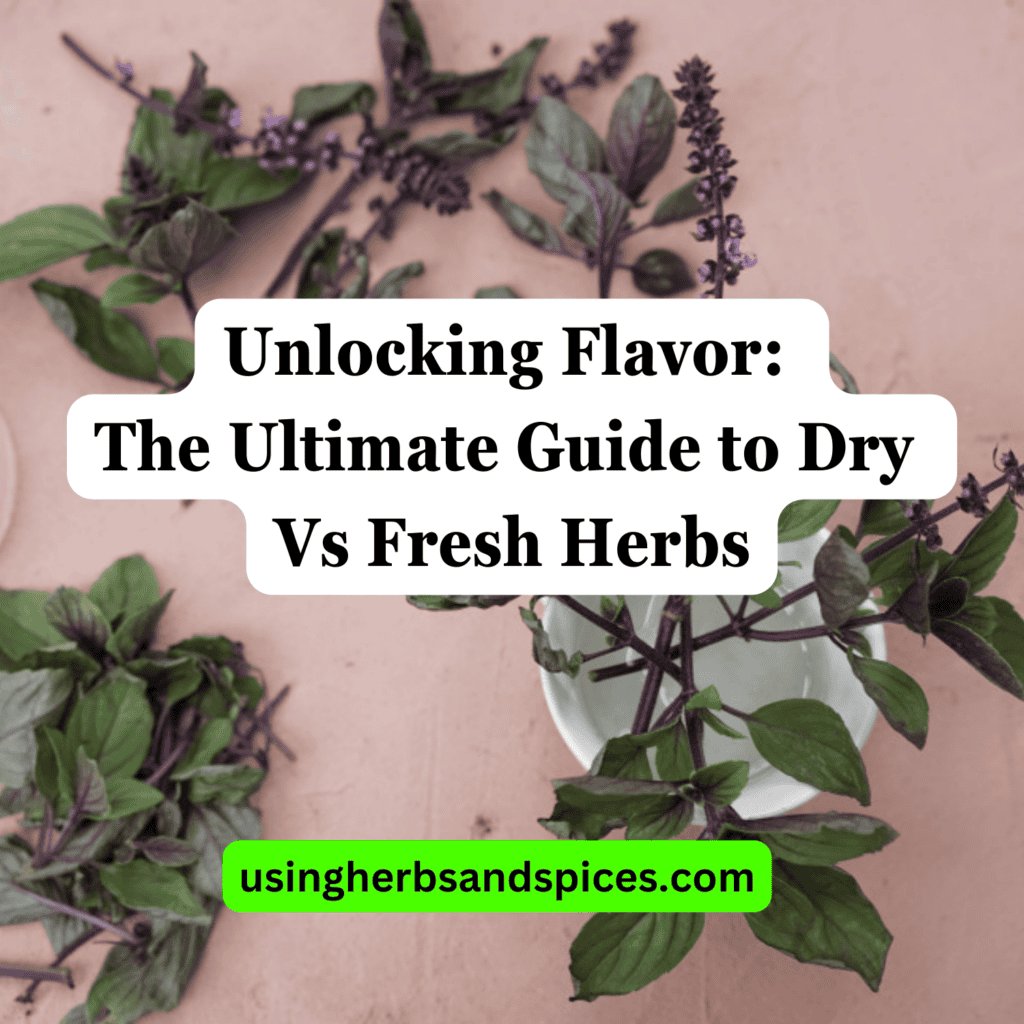SUMMARY: Fresh herbs bring a burst of flavor ideal for immediate use, while dried herbs offer a concentrated taste suitable for longer cooking times. Knowing when to use each can transform your dishes from good to amazing.
Ever wondered why your dishes lack that restaurant-quality flavor?

Understanding the subtle, yet crucial difference between fresh and dried herbs could be the game-changer you’re looking for.
- The unique characteristics and benefits of fresh herbs
- How drying herbs alters their flavor profile
- Direct comparison of fresh vs. dried herbs in culinary use
- Practical tips for choosing and using both types of herbs in your cooking
Keep reading to discover how to select the right type of herb for your dishes, empowering you to enhance flavors like a professional chef.
Understanding Fresh Herbs
Fresh herbs, with their vibrant colors and compelling aromas, are nature’s way of adding nuances and layers to the flavor profile of any dish. They are often added towards the end of the cooking process to preserve their delicate flavors and fresh, green aesthetic. The moisture content in fresh herbs not only contributes to their fresh taste but also affects how they interact with other ingredients, creating a harmony of flavors that can elevate a simple dish to something extraordinary.
- Mint, with its cool, refreshing taste, is perfect for salads and cocktails.
- Basil, offering a sweet and savory flavor, excels in Italian dishes like pesto and tomato sauces.
- Cilantro, known for its bold, citrusy punch, is a staple in Mexican and Asian cuisines.
Choosing fresh herbs means taking into account their seasonality and the immediate impact they have when added to dishes. Fresh herbs are not just ingredients; they’re an experience, bringing a vivid burst of life straight from the garden to your kitchen.
The Art of Drying Herbs
The process of drying herbs is both an art and a science, transforming leafy plants into concentrated bundles of flavor. When herbs are dried, they lose moisture in a controlled environment, either naturally or through the use of dehydrators. This reduction in water content not only prolongs the shelf life of the herbs but also intensifies their flavors. However, it’s important to note that while some herbs retain their aromatic essence, others may develop a more muted profile.
Drying can have a profound effect on an herb’s flavor characteristics. For example, oregano, thyme, and rosemary become more potent as they dry, allowing their distinctive tastes to pierce through robust dishes such as stews and roasts with greater fervor. On the other hand, delicate herbs like basil and parsley might lose some of their fresh, bright notes but gain in concentration, making them ideal for infused oils or seasonings where their essence can slowly meld into the dish.
Understanding the transformation that drying causes is crucial for making informed decisions about when to use dried herbs over their fresh counterparts. While dried herbs offer convenience and a longer shelf life, they excel in dishes that cook for longer periods or at high temperatures, where their concentrated flavors can permeate and enhance the meal’s overall taste profile.
Flavor Impact Comparison
When herbs are dried, the moisture evaporation concentrates their flavor, often making them more potent than their fresh counterparts. This concentrated flavor profile can significantly alter the taste of dishes. For instance, dried oregano has a more intense flavor, ideal for robust, cooked dishes like stews and sauces, where it can simmer and infuse its essence over time. On the other hand, fresh herbs, with their subtle and delicate flavors, are perfect for lighter dishes, such as salads and dressings, where their fresh, aromatic characteristics can shine without overpowering the dish.
Understanding the flavor impact of dried versus fresh herbs is crucial in achieving the desired outcome in cooking. In general, dried herbs are best added at the beginning of the cooking process to allow their flavors to meld with the dish. Fresh herbs, however, are often best when added towards the end of cooking or as a garnish to preserve their vibrant color and fresh flavor. This strategic use of herbs can elevate the dining experience by adding depth and dimension to the flavor profile of meals.
Practical Tips for Using Herbs
Selecting the right herbs is the first step toward enhancing your dishes. When choosing fresh herbs, look for vibrant leaves without any signs of wilting or browning. For dried herbs, aim for those not close to their expiration dates to ensure they still possess most of their aromatic oils.
In terms of storage, fresh herbs often last longer when stored in a glass of water in the refrigerator, similar to how you would keep fresh flowers. Dried herbs, on the other hand, should be kept in a cool, dark place in tightly sealed containers to preserve their flavor as long as possible.
When incorporating herbs into your cooking, a general rule of thumb is to use a three-to-one ratio of fresh to dried herbs because of the concentration of flavor in dried herbs. However, the potency of dried herbs decreases over time, so you may need to adjust this ratio. Additionally, begin with a conservative amount and taste as you go, since you can always add more but cannot remove the herb once it’s been incorporated.
Finding the right balance between fresh and dry herbs can transform your cooking, providing an array of flavors and aromas that elevate even the simplest dishes. Experimenting with these tips can help you discover your personal preferences and enhance your culinary repertoire.
Maximizing Flavor: Fresh vs. Dried Herbs
In this exploration of fresh versus dried herbs, we’ve uncovered crucial insights into how each enhances dishes in unique ways.
- Fresh herbs offer a vibrant burst of flavor and color, ideal for finishing dishes or when freshness is paramount.
- The drying process concentrates the flavors of herbs, making dried herbs more potent and suited for longer cooking times.
- Understanding when and how to use each type can elevate your cooking, providing depth or brightness as needed.
- Substitution between dry and fresh herbs is possible, with the right knowledge of ratios and the impact on overall taste.
- Experimenting with both types in various dishes can lead to personalized, preferred blends that enhance every meal.
Armed with these insights, chefs and home cooks alike can confidently use fresh and dried herbs to bring their culinary creations to life, tailoring each dish to their taste preferences and the desired flavors. Encouraging experimentation and adaptation, this comprehensive comparison aims to inspire creativity in the kitchen.
Enhancing Dishes: Dry Vs. Fresh Herb Comparison FAQs
What are the best conditions for storing herbs?
The best conditions for storing herbs vary depending on whether they are fresh or dried. Fresh herbs ideally should be stored in the refrigerator, wrapped in a damp paper towel and placed inside a plastic bag, or with their stems submerged in a glass of water. Dried herbs, on the other hand, should be kept in a cool, dark place in an airtight container to preserve their flavor and extend their shelf life.
How long do dried herbs last compared to fresh ones?
Dried herbs have a significantly longer shelf life than fresh herbs. While fresh herbs can last up to a week or two when stored properly in the refrigerator, dried herbs can maintain their potency for up to 1-3 years if stored in a cool, dark place in airtight containers. However, it’s essential to check for any loss of aroma or flavor which indicates that the herbs are past their prime.
Can you substitute dried herbs for fresh in recipes? If so, in what ratio?
Yes, you can substitute dried herbs for fresh in recipes, but the ratio differs due to the concentrated flavor of dried herbs. Generally, the rule of thumb is to use one-third the amount of dried herb compared to fresh. If a recipe calls for 1 tablespoon of fresh herb, you should use 1 teaspoon of dried as a substitute. It’s crucial to adjust according to taste, as the potency of herbs can vary significantly.









